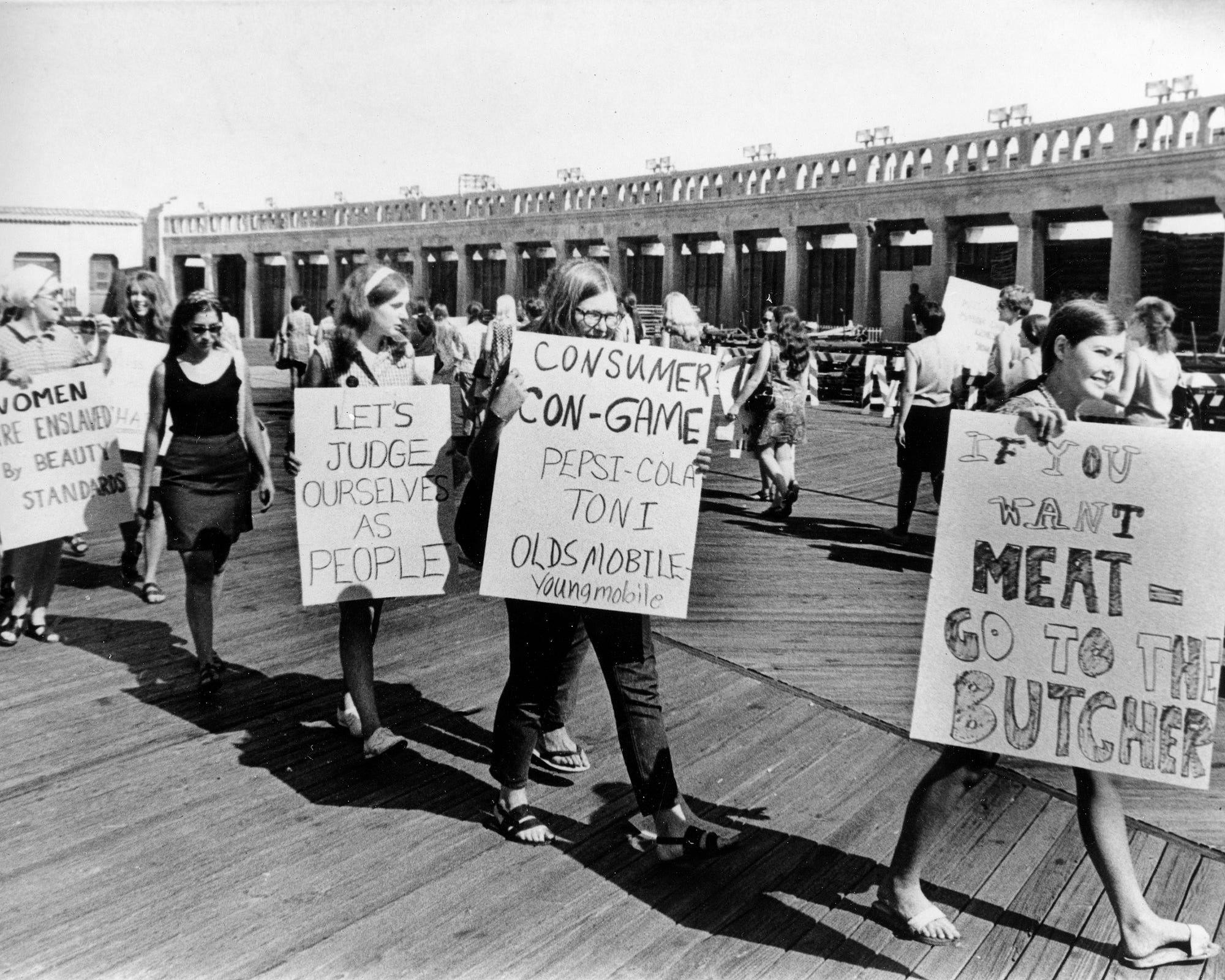On September 7th, 1968, one of the most legendary protests by second-wave feminists took place when nearly 400 women protested against the Miss America pageant outside of the Atlantic City Convention Center. Decades ago, the pageant was incredibly important to American culture - people relished the campy talent and unironically reviewed and rated the young women in their ballgowns and bathing suits. Organizer of the event Robin Morgan wrote that the women were protesting the pageants promotion of the “ludicrous ‘beauty’ standards we ourselves are conditioned to take seriously.” During the protest, men were not allowed to participate (unless it was to drive the female protesters to the event): “Male chauvinist-reactionaries on this issue had best stay away, nor are male liberals welcome in the demonstrations. But sympathetic men can donate money as well as cars and drivers” organizers instructed. However, while the group originally intended to burn symbols of oppression in a “Freedom Trashcan,” they were unable to secure a fire permit. Instead, they erected a giant trash can on the board walk into which mops, pots, copies of women’s magazines and Playboy, false eyelashes, high heels, hair rollers, and girdles and bras were simply deposited rather than burned.
However, there were erroneous reports in the press that the heap of material was set ablaze. A female reporter named Lindsy Van Gelder covering the protest drew an analogy between the feminist protesters and the Vietnam War protesters who burned their draft cards. From that, the bra burning trope was wrongly and permanently attached to the event and became a catch-phrase of the feminist era.
Although there was no physical flame, the internal fire of the activists sparked them to get into the hall and unfurl a bedsheet from the balcony that read Women’s Liberation before getting thrown out. And the organizers also penned a manifesto - “It should be a groovy day on the boardwalk in the sun with our sisters” it read. The document contains a ten point litany of grievances, with section titles decrying “Miss America as Military Death Mascot,” “The Woman as Pop Culture Obsolescent Theme,” “The Irrelevant Crown on the Throne of Mediocrity,” and “The Degrading Mindless-Boob-Girlie Symbol.”
And just as the struggle to be treated as more than a “Mindless-Boob-Girlie” is far from over, it also did not begin with their protest in the 1960s. Nearly a century earlier, in 1873, feminist author Elizabeth Stuart Phelps Ward encouraged women to “Burn up the corsets! . . . No, nor do you save the whalebones, you will never need whalebones again. Make a bonfire of the cruel steels that have lorded it over the contents of the abdomen and thorax so many thoughtless years and heave a sigh of relief, for your emancipation, I assure you, has from this moment begun.”


Elise, this was a very well written and interesting post. I did not know that the whole story about women burning their bras at a protest never actually happened. I also found it interesting that the protesting women did not allow men to participate, I would have thought that they would have liked all the help they could get (in terms of numbers) in proving their point. I did some further research into the feminist protests of today and I found a fascinating article that described the Take Back Our Night movement. This movement is protesting the misconception that women "ask for" rape by wearing revealing clothing, I found it interesting and I think you may too. Thanks for such a great post!
ReplyDeletehttp://www.dbknews.com/2017/01/21/womens-march-on-washington-protest-history/
Elise, I found your post very interesting! I was especially intrigued by the fact that men were not allowed to participate in the protest (only allowed to drive the women). Today, the feminist movement has changed drastically, many believing that men need to also be agents of change, as seen through the He for She campaign. I found the speech from the protest and was surprised by how radical the following statement is: "Male chauvinist-reactionaries on this issue had best stay away, nor are male liberals welcome in the demonstrations. But sympathetic men can donate money as well as cars and drivers. Male reporters will be refused interviews. We reject patronizing reportage. Only newswomen will be recognized." Rather than calling out opponents of feminism, this woman attacks men in support of the movement. While I can understand that the protest was meant to show female strength, I fail to see how alienating all men would have helped the movement's image as pro-women's rights (and not anti-men).
ReplyDeletehttp://www-personal.umich.edu/~mlassite/discussions261/missamerica.html
Great post Elise! I found it very interesting that something that has become such a famous symbol of the feminist revolution, such as the bra burning, never actually happened. When reading your article, I couldn't help but connect it to Paul Revere's midnight ride, which symbolized the American dedication to the fight for independence. However, much like the bra burning, it too never actually happened, or at least not in the same way that the famous poem told. However, both "events" bring up interesting ideas about how symbols are oftentimes much more powerful in conveying a story than the story itself. Thanks for sharing!
ReplyDeletehttps://www.hackettstown.org/cms/lib7/NJ01000669/Centricity/Domain/1028/PaulRevere-Facts-Annotation.pdf
This was a very well written article about the beauty pageant protest on september 7th, 1968. This protest as well as many others show that the actions taken by congress and the legislation that was issued was simply not enough nor did it effectively change anything. The Equal Pay Act of 1963 had little to no effect on the wage gap for the first few years. It reminds one of the phrase "with all deliberate speed", as it was used in the case of Brown V. Board of Education decision to integrate schools. Even today women only make about 80% of a man's wage at an equal substance job. Besides legislation not being effectively controlled, societal norms were to be changed by protests and feminist movements, not the government.
ReplyDelete